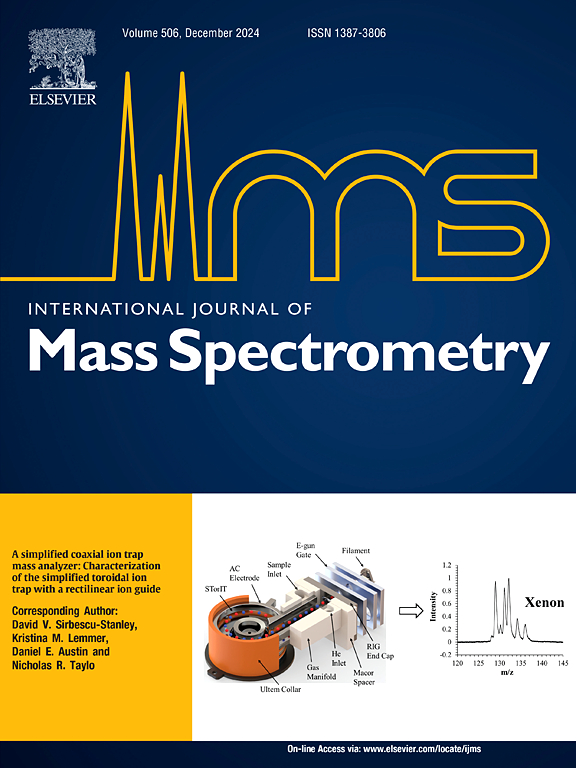Molecular simulation methods of evaporating electrosprayed droplets
IF 1.7
3区 化学
Q3 PHYSICS, ATOMIC, MOLECULAR & CHEMICAL
引用次数: 0
Abstract
A robust methodology for molecular simulations of evaporating droplets that enables comparison between the dynamics of the process of interest and the solvent evaporation rate has already been developed (Oh and Consta, 2017). The competition of these dynamics will determine the mass spectrum. However, the success of the approach depends on the accurate and effective treatment of electrostatic forces. Often, in droplet simulations, bulk solution parametrized force-fields are used where the Coulomb forces are directly taken into account with a cut-off distance longer than the droplet diameter. On the one hand this approach is inefficient for large droplets because the computational cost increases as the square of the number of the atomic sites, and on the other hand the force field is slightly different from that has been parametrized for the bulk solution. The effect of this new force field in the conformations of macromolecules is still unknown. Multilevel summation method (MSM) has been developed (Hardy et al. 2015) for the efficient treatment of electrostatic forces in non-periodic and semi-periodic systems, charged or neutral. MSM maintains the same force field in droplets as in the bulk solution. We compare MSM with direct electrostatic treatment in droplets. The comparison shows free energy differences between conformations of short peptides along the radius of gyration order parameter that indicate the need for validation of the direct method. We demonstrate the usage of MSM to study Rayleigh jet formation and charge emission from droplets. We conclude that robust approaches for droplet simulations that can be used with a force field of any complexity are available and can be implemented within many of the available open-source molecular modeling softwares. In the near future, the presented approach may provide reliable reference mass spectra for experiments, where the deviations from the experimental data may reveal valuable information about the processes that take place within the instrument.

蒸发电喷雾液滴的分子模拟方法
目前已经开发出一种用于蒸发液滴分子模拟的强大方法,可以对相关过程的动力学和溶剂蒸发率进行比较(Oh 和 Consta,2017 年)。这些动力学的竞争将决定质谱。然而,该方法的成功取决于对静电力的准确有效处理。在液滴模拟中,通常使用体溶参数化的力场,其中库仑力被直接考虑在内,截止距离长于液滴直径。一方面,这种方法对于大液滴来说效率不高,因为计算成本随着原子位点数量的平方而增加;另一方面,这种力场与体溶液参数化的力场略有不同。这种新力场对大分子构象的影响尚不清楚。为了有效处理非周期性和半周期性系统(带电或中性)中的静电力,人们开发了多级求和法(MSM)(Hardy 等,2015 年)。MSM 使液滴中的力场与主体溶液中的力场保持一致。我们将 MSM 与液滴中的直接静电处理进行了比较。比较结果表明,短肽构象在回旋半径阶参数上存在自由能差异,这表明需要对直接方法进行验证。我们演示了如何使用 MSM 研究液滴的瑞利射流形成和电荷发射。我们的结论是,液滴模拟的稳健方法可以与任何复杂程度的力场一起使用,并且可以在许多可用的开源分子建模软件中实现。在不久的将来,所介绍的方法可能会为实验提供可靠的参考质谱,其中与实验数据的偏差可能会揭示仪器内部过程的宝贵信息。
本文章由计算机程序翻译,如有差异,请以英文原文为准。
求助全文
约1分钟内获得全文
求助全文
来源期刊
CiteScore
3.60
自引率
5.60%
发文量
145
审稿时长
71 days
期刊介绍:
The journal invites papers that advance the field of mass spectrometry by exploring fundamental aspects of ion processes using both the experimental and theoretical approaches, developing new instrumentation and experimental strategies for chemical analysis using mass spectrometry, developing new computational strategies for data interpretation and integration, reporting new applications of mass spectrometry and hyphenated techniques in biology, chemistry, geology, and physics.
Papers, in which standard mass spectrometry techniques are used for analysis will not be considered.
IJMS publishes full-length articles, short communications, reviews, and feature articles including young scientist features.

 求助内容:
求助内容: 应助结果提醒方式:
应助结果提醒方式:


